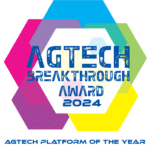Sulphur: Are You Really Applying the Right Rate?
Sulphur (S) may be the most variable nutrient we see in western Canadian and northern great plains soils, especially in glacial till soils. It often poses tremendous opportunity for variable rate, to not only address very deficient areas with higher rates, but also reduce rates in soils high in sulphur.
Sulphate-S is very mobile in the soil and will move with soil water. It is also associated with salts so soils with a high EC (even just slightly saline) normally have very high sulphur levels. 1000+ lbs of S in the top 12” is not uncommon if a soil is saline. Like nitrogen, sulphur is also mineralized from organic matter so organic matter is an important source to consider for supplying S to the crop in-season. As a result, high organic soils (peat, muck) rarely need any added S, while low organic matter sandy soils or eroded knolls can be very responsive. Hydrology within a field is also a significant factor affecting sulphur. Water drives movement of nutrients in solution, as well as soil erosion. So, sulphur typically moves away from “water shedding” areas (upper landscape positions) to “water collecting” areas (lower landscape positions). You can read an example of this here. So it’s a combination of soil and water properties that drives sulphur availability – exactly what SWAT MAPS provides us.

Figure 1. Severe S deficiency in zone 1 vs. no deficiency in zone 7 in a zero rate S check strip.
Sulphur is available to the crop only as the sulphate ion (SO4-), but is applied primarily in 2 forms:
- Sulphate: Products such as ammonium sulphate (AMS), liquid ATS, potassium sulphate (SOP), K-Mag®, Trio, MicroEssentials®, 40 Rock™, Amidas®, and gypsum all supply some amount of available sulphate to the crop relatively quickly, although the solubility and concentration of S can vary. Gypsum for example, is not as soluble but has proven to be an effective sulphur source in the year of application.
- Elemental-S: Tiger 90CR® (and other pastille sulphurs), Super S, MicroEssentials®, and Bio-Sul are examples of products that have elemental-S in them. Elemental-S sources need to be oxidized by soil bacteria before they become available for crop uptake. The rate of this reaction depends on temperature, moisture, sulphur particle size, soil pH, and dispersion of particles in the soil.
Both forms of S are useful tools and have pros and cons. The focus of this post is to elaborate on how we can exploit these traits of each using variable rate with SWAT MAPS.
Take the field below as an example. There’s significant texture, pH, and organic matter variability. Zone 10 is a muck soil in depressions that is considered slightly saline based on EC, while zones 1 and 2 are upper landscape positions that are relatively sandy.



Considering a perfect agronomic scenario, a product like KMag, SOP, or gypsum would be a nice fit on the acidic sandier soils in zones 1-4, given these products do not cause further acidification of the soil, and also provide nutrients that are often needed in sandier soils. Gypsum may even help reduce leaching potential of S given its lower solubility. On the other hand, zones 5-8 may not need much applied S given higher soil S, higher mineralization potential, and being mid to lower landscape positions. Zones 9 and 10 would not be expected to respond at all. So as an example, a two bin fertilizer spreader could be used to apply the following prescription prior to seeding canola:
Alternatively, in a different environment with highly calcareous soils and high pH, elemental-S sources could be utilized as a “slow release” source of S over a longer period of time, supplemented by sulphate sources for higher S demand crops. In this situation, the acidification from both elemental S and AMS could be beneficial. In the example field below, zone 1s are relatively eroded knolls and zone 10s are poorly drained depressions. While there is no salinity, there is a lot of sulphate movement with water across the landscape, as well as some variability in mineralization due to moisture and organic matter differences. A potential strategy for corn could be an application of elemental-S (Tiger 90) to provide slowly available S to minimize leaching losses, and MicroEssentials® SZ to supply some additional S (50:50 sulphate:elemental) as well as P and Zn where soils are testing low.


The point is, using VR with SWAT MAPS allows you to utilize ALL the 4Rs spatially throughout a field, using the right source and the right rate in the right place at the right time. And while some parts of the fields receive high rates, other parts have low rates and the average rate of S applied is typically the same or lower than a farm would apply as a flat rate. In examples of variability like this, which are quite common for sulphur, a flat rate would NOT be applying the right rate on a large amount of acres.
Clearly, we have the tools to go beyond using “field average rates." We can now isolate specific soil types and landscape positions to treat them as they should be treated. It doesn’t end with sulphur; in fact it doesn’t end with nutrients. We can think about this management strategy with all soil applied inputs! Lime, manures, seed, and soil applied herbicides should all be applied based on soil, water, and topography variability. You just need to map it, measure it, and manage it.
References:
Franzen, D., & Grant, C. A. (2008). Sulphur response based on crop, source, and landscape position. Sulphur: A missing link between soils, crops, and nutrition, 50, 105-116.
Schoenau, J. J., & Malhi, S. S. (2008). Sulphur forms and cycling processes in soil and their relationship to sulphur fertility. Sulphur: A missing link between soils, crops, and nutrition, 50, 1-10.









